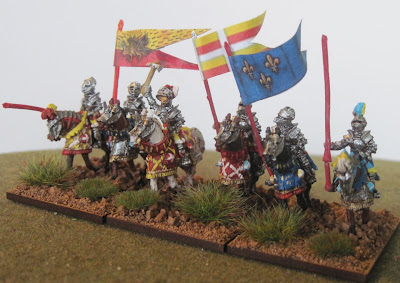Cavalry could be complex. Consider the French Gendarme, he is organised by the Lance. This is where complexity begins. The Lance consists of the gendarme himself and depending upon the period a varied number of followers. The followers themselves have different functions. There should be archers and pages.
The archers are sometimes just that. They might sometimes fight on foot and might not too. At other times they were what others might call a Demi-lancer.
On occasion they perform both functions.
The pages don’t get much of a write up but we see them, I think, now and then. Sometimes they are operating in a group murdering the wounded and unhorsed gendarmes from the other side. There might be the chance of ransom if someone aristocratic passed by. Otherwise, it was a rainy night in Pavia for the stricken.
Sometimes the archers didn’t have any bows and fought as lance armed heavy cavalry. Sometimes they had bows but were terrible shots, couldn’t hit a Palazzo with a Lira De Braccio type of thing. On other occasions they had bows and were proficient in their use of them. They might dismount to shoot or might not. The type of bow used could vary, crossbows and long bows and short bows were all possible.
The only constant in an Ordnance Lance is the gendarme who is always a heavily armoured lancer. Even then he might have barding for his horse or not, or just a head piece or no protection at all. The archer appeared in a variety of forms
This means that if our sources say there were 100 Lances it could mean 300 men or 500 or more. It was conditional and all we can say is that it certainly doesn’t mean 100 men.
For my own convenience I’ve represented the French Lance of the Ordnance as a grand composite unit. First are the gendarmes, then the archers and then the true skirmishers. That is to say three units under one banner. I think that probably merits giving them a sub commander.
Anyhow, here is the current Cavalry Combat Table from Gonzalo. It owes a fair bit to Furioso.
|
unit |
Number of ranks fighting |
Number of dice per base |
Special rules |
|
Gendarmes |
1 |
4 |
All units facing Gendarmes lose 1 D6 per base from their combat dice. |
|
Gentes De Arms |
1 |
4 |
When fighting un-barded cavalry, a score of 5 will cause a horse kill on the enemy unit. The rider can no longer fight with his unit. |
|
Ducal cavalry |
1 |
4 |
None |
|
Heavy cavalry |
1 |
3 |
None |
|
Stradiots |
2 |
2 |
Can evade. In the first round of combat any score of 6 by the Stradiots will cancel an opponent’s hit and add it to its own total. |
|
Genitors |
2 |
2 |
Can evade. In the first round of combat any score of 6 by the Genitors will cancel an opponent’s hit, and add it to its own total. |
|
Arquebusiers and Cross bows |
1 |
2 |
Can evade if charged |
|
General or Commander fighting |
|
|
The unit joined by the general rolls 1 additional D6 per base. |
You can see the sort of dynamics I want to model. I should add, I'm going down the Saving Throw route.
The figures above are from Venexia, Legio Heroica and Khurasan. I think they match each other well enough together.
While we are discussing Gonzalo I've made some progress on the Cards. Here you can see the Artillery and Charge Cards. I wanted them to look distinct from the Unit Cards and so used original artwork from the period .
You can see some Unit Cards here.
I've also expanded the Charge Card to include the Swiss, as Gonsalvo wisely advised in last week's comments. More of that when we see the completed and expanded Swiss.
More soon.








I can see how easy it would be to get confused on the cavalry front, but you've explained things rather nicely for a novice like myself. The cards look brilliant BTW and the figures are superb too!
ReplyDeleteThanks Steve. Yeah, it's a maze and it also means that different Lance units could have different components and therefore different abilities. I feel I'm starting to get somewhere on this one now.
ReplyDeleteIve always viewed the French 'archers' as a heavy cavalry unit, armed with light lances and crossbows. It was always the description used by George Gush in his wonderful book on renaissance armies and his rules. I tend to use them as a supporting unit for their heavier gendarmes. The lance was more a term than a reality. The best example being Charles the Bolds 'lance, which saw each type massed with others of that type ie longbowmen who rode to battle, coustilliers armed with light lances and pikemen.
ReplyDeleteYes, that was the received wisdom back in the day. George's book was a great resource for all of us then.
ReplyDeleteMore information has emerged since, or was always there but not in English perhaps. The Lance was a technical term that reflected a basis upon which money changed hands. A contractual thing if you like. As such it was very real.
I've described the varying components of a French Ordnance Lance above. The components parts of a Lance always supported the Gendarme. How they did it could take a number of forms.
It certainly is a confusing period OB.The figures look great as do the cards. Very posh indeed!
ReplyDeleteThanks Ray. It was a time of great experimentation I suppose.
ReplyDeleteBravo!
ReplyDeleteMuch appreciated Jeff.
ReplyDeleteOnce again, concur with your thoughts and analysis; the "Lance" can be a confusing concept!
ReplyDeleteThanks Gonsalvo, it is a tricky one.
ReplyDelete